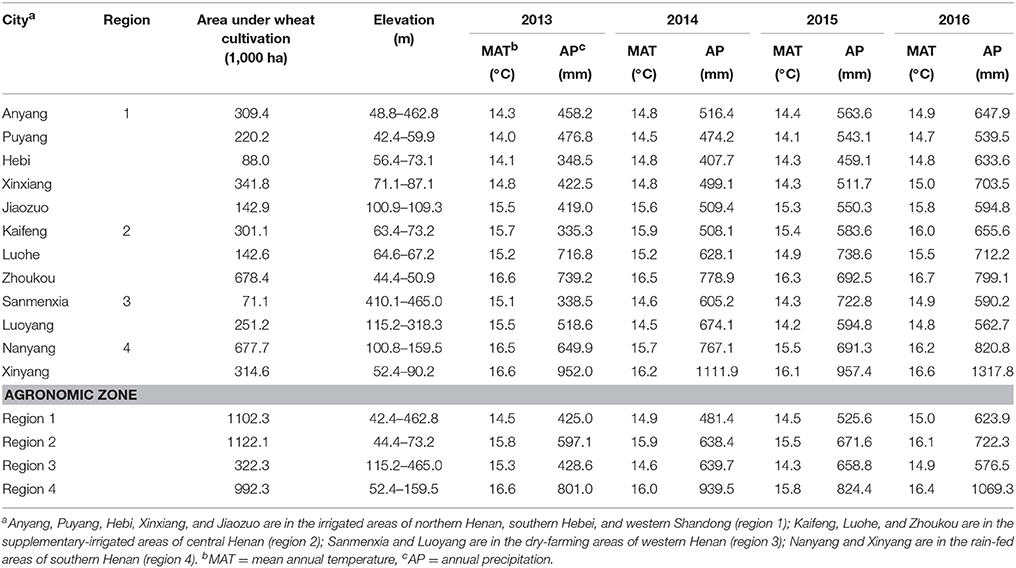- Institute of Plant Protection, Henan Academy of Agricultural Sciences, Key Laboratory of Integrated Pest Management on Crops in Southern Region of North China, Ministry of Agriculture of the People's Republic of China, Zhengzhou, China
The distribution frequency of pathogenic fungi associated with root and crown rot of winter wheat (Triticum aestivum) from 104 fields in the North China Plain was determined during the period from 2013 to 2016. The four most important species identified were Bipolaris sorokiniana (24.0% from roots; 33.7% from stems), Fusarium pseudograminearum (14.9% from roots; 27.8% from stems), Rhizoctonia cerealis (1.7% from roots; 4.4% from stems), and Gaeumannomyces graminis var. tritici (9.8% from roots; 4.4% from stems). We observed that the recovered species varied with the agronomic zone. Fusarium pseudograminearum was predominant in regions 1 and 3, whereas F. graminearum, F. acuminatum, and R. cerealis were predominant in regions 2 and 4. The incidence of F. pseudograminearum and R. cerealis was significantly different between regions 1 and 4, while no significant association was found in the distribution of the other species and the agronomic zones. A negative correlation between the frequency of occurrence of F. pseudograminearum and mean annual precipitation during 2013–2016 (r = −0.71; P < 0.01) in the North China Plain and a positive correlation between the mean annual precipitation during 2013–2016 and the frequency of occurrence of F. asiaticum (r = 0.74; P < 0.01) were observed. Several Fusarium species were also found with low frequencies of ~2.1%−3.4 % (F. graminearum, F. acuminatum, and F. sinensis) and ~0.1%−1.3% (F. equiseti, F. oxysporum, F. proliferatum, F. culmorum, F. avenaceum, and F. asiaticum). In more than 93% of the fields, from the root and crown tissues of wheat, two or more root and crown rot species were isolated. The coexistence of Fusarium spp. and B. sorokiniana in one field (65.4%) or in individual plants (11.6%) was more common than for the other species combinations. Moreover, this is the first report on the association between F. sinensis and root and crown rot of wheat. Our results would be useful in the framing guidelines for the management of root and crown rot fungi in wheat in different agronomic zones of the North China Plain.
Introduction
China has one of the largest wheat-planting areas (21 million ha), worldwide, and produces 87.7867 million tons of wheat, which is 19% of the total world production (National Statistical Year book 2014). The North China Plain is the major wheat producing area, accounting for 72% of the China's output. However, the production in this area is increasingly being effected by the root and crown rots of wheat, which cause whiteheads at the filling stage and reduce the crop yield (Li et al., 2012; Xu et al., 2014, 2016; Ji et al., 2016). The climatic conditions vary across the Yellow River, the Yangtze River, and the Haihe River of Henan in the North China Plain, the average annual temperature rang from 13 to 16°C, the rainfall from 300 to 1,100 mm, and the elevation from 23.2 to 2413.8 m. The rainfall mostly occurs in summer (June, July, and August) and is the lowest in July. The wheat-growing areas of Henan and its neighboring provinces in the North China Plain can be divided into four regions according to the soil type and climate (Hu and Yin, 2014); these include the irrigated areas of northern Henan, southern Hebei, and western Shandong (region 1), the supplementary-irrigated areas of central Henan (region 2), the dry-farming areas of western Henan (region 3), and the rain-fed areas of southern Henan (region 4) (Figure 1, Table 1). As the incidence of root and crown rot diseases of wheat are reported to be different in the four agronomic zones and several pathogenic fungi can cause the same disease in wheat, the distribution of predominant species associated with root and crown rot and their relationship with the climate variables have been important issues for research in the North China Plain.
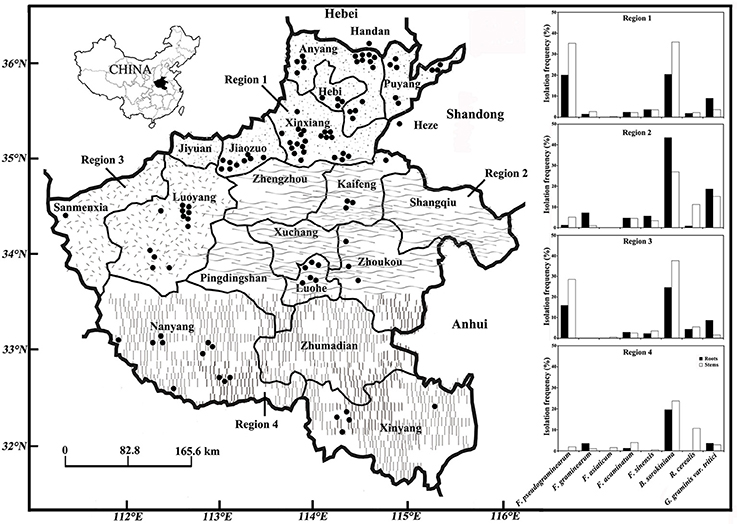
Figure 1. Isolation frequency of Fusarium spp., Bipolaris sorokiniana, Rhizoctonia cerealis, and Gaeumannomyces graminis var. tritici from symptomatic wheat roots and stems from the major wheat- producing areas in the North China Plain during 2013–2016. The area of scattered dots indicates the irrigated areas of northern Henan, southern Hebei and western Shandong (region 1) including Anyang, Hebi, Puyang, Xinxiang, Jiaozuo, Handan, and Heze; the area of wavy lines indicates the supplementary-irrigated areas of central Henan (region 2) including Kaifeng, Luohe, and Zhoukou; the area of dashed lines indicates the dry-farming areas of western Henan (region 3) including Sanmenxia and Luoyang; the area of vertical lines indicates the rain-fed areas of southern Henan (region 4) including Nanyang and Xinyang. The symbol “•”represents the sampling places of diseased wheat associated with root and crown rot fungi.
The root and crown rots are important diseases of cereals, worldwide, and are found to occur in the major winter wheat growing regions in China (Zhang et al., 2015). The infection of the root and crown causes the vascular system to constrict, which limits the uptake and transport of water, causing whiteheads at the filling stage (Cook, 2010; Poole et al., 2013). There are four important diseases of the root in China as well as in other countries of the world, namely Fusarium root and crown rot (FCR), common root and foot rot (CRR), sharp eyespot, and take-all (Burgess et al., 2001; Fernandez et al., 2009; Cook, 2010). The recognition of the role of soil-borne pathogens as factors limiting the production of wheat in most of the areas of the North China Plain is problematic. The identification and quantification of root and crown rot diseases involves more laborious procedures compared to those involved in simple visual observations.
Fusarium root and crown rot is caused by a complex of species that includes Fusarium pseudograminearum (O'Donnell and T. Aoki), F. graminearum (Schwabe), and F. culmorum (Wm. G. Smith) Sacc. (Leslie and Summerell, 2006; Cook, 2010; Moya-Elizondo, 2013). Four other Fusarium species, including F. acuminatum (EIIis and Everh.), F. avenaceum (Fr.:Fr.) Sacc., F. crookwellense (L. W. Burgess, P. E. Nelson, and Toussoun), and F. poae (Peck) Wollenw., also infect the wheat roots, lower culms, and leaf sheaths but are less virulent and more environmentally or geographically restricted than the three species mentioned above (Smiley and Patterson, 1996; Paulitz et al., 2002; Cook, 2010; Moya-Elizondo et al., 2011). Several other genera also cause wheat root and crown rot, including the causal agents of CRR, Bipolaris sorokiniana (Sacc.) Shoemaker (= Cochliobolus sativus); the causal agents of take-all, Gaeumannomyces graminis (Sacc.) Arx and D. L. Oliver, and G. graminis var. tritici J. Walker and the causal agents of sharp eyespot, Rhizoctonia spp. The Rhizoctonia spp. associated with wheat root and crown rot disease include Rhizoctonia solani (J. G. Kühn), R. oryzae (Ryker and Gooch), and R. cerealis (E. P. Hoeven).
Several surveys of FCR-causing organisms have been conducted in the dryland wheat-growing regions around the world (Cook, 2010). Although the causal agents for FCR are frequently a complex of F. pseudograminearum and F. culmorum, other pathogens capable of causing crown infection include F. graminearum, F. acuminatum, F. avenaceum, and Microdochium nivale (Fr.:Fr.) Samuels and I. C. Hallett [syn. F. nivale Ces. ex Berl. and Voglino; teleomorph Monographella nivalis (Schaffnit) E. Müll.]. It is widely accepted that F. pseudograminearum is the dominant species responsible for crown rot in the arid zones of the Pacific Northwest (PNW) and Australia (Smiley and Patterson, 1996; Backhouse and Burgess, 2002; Backhouse et al., 2004; Poole et al., 2013). Fusarium culmorum was reported to be the predominant species in eastern Victoria and South Australia (Smiley and Patterson, 1996; Backhouse and Burgess, 2002); and F. graminearum was reported to be virulent in eastern Australia and southern Europe. However, other Fusarium spp. were more restricted, geographically. Fusarium acuminatum, F. avenaceum, and M. nivale were reported to be prevalent in southern Australia (Williams et al., 2002), the PNW (Backhouse and Burgess, 2002; Paulitz et al., 2002), and Europe, respectively.
Besides Fusarium spp., B. sorokiniana associated with CRR was reported to be prevalent in the arid and semiarid regions of western USA and in Jiangsu province of China, and was found to be a primary component of the cereal foot rot complex in Oregon and Washington in the USA (Smiley and Patterson, 1996; Li et al., 2011). Gaeumannomyces graminis var. tritici is widely distributed in Australia, Europe, South Africa, Japan, Brazil, Chile, Argentina, China, and most of the North America. The Rhizoctonia root rot and bare patch are caused by R. solani, which causes lesions and pruning of the seminal and crown roots, particularly in the rained cereal production systems in Australia and the PNW (Paulitz et al., 2002). Rhizoctonia oryzae also causes pre-emergence and post-emergence damping-off, but this is not common with R. solani in the PNW (Paulitz et al., 2002). Rhizoctonia cerealis has been reported to be widespread in China and Turkey where is an economically important crown pathogen of wheat (Tunali et al., 2008; Chen et al., 2009).
The distribution of species and root and crown rot disease in certain wheat-growing regions is influenced by the climate (Backhouse and Burgess, 2002; Leslie and Summerell, 2006; Bentley et al., 2009; Cook, 2010; Moya-Elizondo, 2013). Among the FCR pathogens, the distribution of F. pseudograminearum isolates was observed to be inversely proportional to the rainfall within a certain range (Smiley and Patterson, 1996; Poole et al., 2013). Fusarium pseudograminearum FCR was more widespread during the low-rainfall years in the PNW of the United States and in the low rainfall (250–500 mm) areas of Australia. On the other hand, F. culmorum was predominant in the high rainfall areas of eastern Australia (>500 mm) and in the cooler and higher altitude areas of Idaho (Backhouse et al., 2004; Strausbaugh et al., 2004; Smiley et al., 2005). The incidence of FCR was reported to differ for different years and wheat varieties, and Fusarium population dynamics were affected by the climate (Smiley and Patterson, 1996; Smiley et al., 2005; Smiley and Yan, 2009). The common root rot is most severe when plants are drought-stressed (Stein, 2010). However, take-all is most severe in wet areas or during the wet years and in irrigated fields (Paulitz, 2010).
Surveys of Fusarium spp. causing wheat crown rot have been conducted throughout the major winter wheat growing regions of China and the frequency of FCR in Henan and Hebei has been recorded (Li et al., 2012; Zhang et al., 2015; Ji et al., 2016). Li et al. (2012) first reported F. pseudograminearum, causing FCR, from the Henan Province in China and it was shown to be the predominant FCR pathogen in Hebei (Ji et al., 2016). However, F. asiaticum and F. graminearum, causing wheat crown rot were predominant in Henan, Hebei and Shangdong in the North China Plain during the period from 2009 to 2013 (Zhang et al., 2015). The common root rot caused by B. sorokiniana has been reported in Heilongjiang and Jiangsu provinces of China (Zhang et al., 1988; Li et al., 2011), but not in the North China Plain. Gaeumannomyces graminis var. tritici and R. cerealis have also been reported to be widespread in China (Chen et al., 2009; Xu et al., 2014).
Although previous surveys of pathogenic fungi associated with root and crown rot disease have been conducted in Henan, Hebei, and Shandong provinces of the North China Plain (Li et al., 2011, 2012; Xu et al., 2014; Zhang et al., 2015), the distribution of F. pseudograminearum and B. sorokiniana in the North China Plain is not known with certainity as to whether there is a coexistence of different species in one field or in an individual plant and whether there are significant differences in the predominance of species associated with root and crown rot between different agronomic zones. Therefore, the distribution of root and crown rot fungi causing wheat white heads was assessed during the period from 2013 to 2016 across the four regions of Henan province in the North China Plain. The objectives of the present study are (i) to determine the distribution of pathogenic fungi associated with root and crown rot in different agronomic zones of Henan and its neighboring provinces, in one field or in individual plant, (ii) to ascertain if the predominant species recovered from an area correlated with the climate variables.
Materials and Methods
Survey of Ecological and Regional Zones and Sampling
This study was performed in four representative wheat-growing regions of Henan and its neighboring cities of Handan in Hebei and Heze in Shandong (Figure 1, Table 1). The wheat fields were selected randomly with respect to the selected region (2–3 fields per village, 2–5 villages per county, 2–5 counties in each region) and severity of disease. The selected fields were at least 5 km apart. The area of each field was in the 2,000–6,667 m2 range. The samples were collected from five sites in the field in a zig-zag pattern (Fang, 1998). Each sampling site was 1–2 m2, and 10–30 m apart. Ten plants were collected from each site, and the ratio of whiteheads in each sample of 10 plants was recorded. Thus, a total of 50 plants were collected from each field. The fields were geo-referenced using a Magellan global positioning system (GPS) meter and numbered accordingly. If a selected field exhibited a low infection rate, the diseased plants were collected from wherever they were found. The diseased stems were collected from 104 fields in 15 cities from May 5 to May 30 during the period from 2013 to 2016 (Feekes growth stages 11.1 Large, 1954).
Isolation, Culture, and Identification of Species
The diseased stems collected from each field were washed thoroughly under tap water. Three diseased crown or stem sections (1–1.5 cm) and three diseased root sections (1–1.5 cm) were collected from each plant (six sections per plant). These sections were surface-sterilized sequentially with 70% ethanol for 10 s and 3% sodium hypochlorite for 1–2 min, rinsed thrice with distilled water, and then dried on a sterile paper towel. The samples were plated onto potato dextrose agar (PDA) (200 g of peeled potato, 20 g of dextrose, and 20 g of agar in 1,000 mL distilled water) medium containing 150 μg/mL streptomycin and 75 μg/mL penicillin (six sections from one stem per PDA plate). If the roots did not show any infection, only three crown or stem sections were selected from the plant. The plates were incubated at 25°C for 3–7 days under a day/night photoperiod of 12/12 h. The degree of infection was recorded and the isolates were then transferred to fresh PDA plates.
The isolates of Fusarium spp. were purified using the single spore isolation protocol described by Xu et al. (2016) and were initially identified morphologically on synthetic nutrient agar (SNA) and carnation leaf agar (CLA) (Leslie and Summerell, 2006). Other fungi were identified using keys based on their colony, hyphal, or conidial morphologies.
The PCR amplification and sequencing of EF-1α from 1120 isolates of Fusarium spp. were conducted using the primer pair, EF1 and EF2 (O'Donnell et al., 2000, 2004; Proctor et al., 2009). The internal transcribed spacer (ITS) sequences of other representative species were amplified and sequenced with the primer pair, ITS1 and ITS4 (White et al., 1990). The PCR products were sequenced by Shanghai Sangon Biological Engineering Co., Ltd. The DNA sequences were aligned and adjusted using DNAStar-SeqMan software (http://www.dnastar.com/). The phylogenetic relationships were inferred with MEGA7.0.18 (http://www.megasoftware.net/megamacBeta.php) using the maximum-likelihood method, with 1,000 bootstrap replicates. The best-fit model of molecular evolution was selected based on the estimation of Bayesian Information Criterion scores.
Environmental Characterization
The climate data were downloaded from the database developed by the Henan Meteorological Bureau (http://www.henanqx.gov.cn/) and were selected from the data available from the weather forecast station nearest to the sample field in each county. These data include six variables for 4-year norms for the period from 2013 to 2016. A correlation analysis of these six variables indicated that most of them were highly correlated. As a result, a subset including mean annual temperature (MAT), mean annual precipitation (MAP), mean temperature in the coldest month (MTCM), and mean temperature in the warmest month (MTWM) were the only variables in the analyses described below.
Virulence Assays
To ensure the representation of a range of geographic origin, the pathogenicity of 35 isolates of Fusarium spp. (five isolates each of F. pseudograminearum, F. graminearum, F. acuminatum, F. sinensis (Z. Zhao and G. Lu), F. equiseti (Corda) Sacc., F. oxysporum (Schlechtendahl emend. Snyder and Hansen), and F. proliferatum (Matsushima) Nirenberg) and five isolates of Bipolaris sorokiniana was tested on wheat seedlings (Triticum aestivum cultivar “Zhengmai 366”) in a glasshouse under 12/12 h (day/night) photoperiod at a temperature of 25/15°C, and relative humidity of 60/80% (±5%) for 35 days using the method described by Mitter et al. (2006).
To prepare the inoculum of macroconidia, the isolates were grown on PDA plates for 3–6 days at 25°C in the dark, and then 10 pieces of PDA colonized by the fungus (0.25 cm2) were placed in 100 mL mung bean liquid medium (4%) and cultured in 250 mL Erlenmeyer flasks at 25°C on an orbital shaker at 150 rpm for 5 days, and then filtered using conventional microscope lens paper (Zhejiang Province Wenzhou Handicraft Factory). The mung bean liquid medium (4%) was prepared by boiling 40 g of green beans in distilled water until the pericarp started to crack-open; the extract was filtered through several layers of cheesecloth and the volume was made up to 1 L with distilled water. The medium was autoclaved for 20 min at 121°C. The concentration of conidia was determined using a hemocytometer and the suspension was then diluted to 1 × 106 spores/mL for seedlings inoculation (Mitter et al., 2006).
The method described by Mitter et al. (2006) was amended for inoculation of seedling stem. Ten wheat seedlings were grown in sterilized soil (50% natural soil and 50% sand, v/v) in plastic pots (diameter = 10 cm) in a glasshouse under 12/12 h (day/night) photoperiod at 25/15°C. Ten days after the emergence, each seedling of “Zhengmai 366” (Triticum aestivum) was inoculated with a 10-μL droplet of a suspension of 1 × 106 spores/mL. One isolate was used to inoculate 30 seedlings (10 seedlings per block). The inoculated seedlings were incubated at near-saturated relative humidity in darkness for 48 h, and then transferred to a glasshouse under 12/12 h (day/night) photoperiod at 25/15°C and a relative humidity of 60/80% (±5%) for 35 days. The degree of disease was rated with one of the five grades, modified from Zhang et al. (2015): 0 = no disease; 1 = trace to 10% of the first leaf sheath discolored; 2 = 11%-25% of first leaf sheath discolored; 3 = 26%-50% of the first leaf sheath discolored; 4 ≥ 50% of the first leaf sheath discolored or obviously necrotic second leaf sheath; 5 = third leaf sheath obviously necrotic or entire plant severely to completely necrotic.
Statistical Analysis
A one-way factorial analysis of variance (ANOVA) (SAS Institute, Cary, NC, USA, Version 8.0, 1999) was used to determine the differences in the proportions of species associated with specific regions or agro-zones and virulence of isolates of root and crown rot fungi. The means for different Fusarium spp. and B. sorokiniana were separated using Fisher's Protected Least Significant Difference Test (P < 0.05). Pearson correlations were calculated to estimate the relatedness among the four-year averaged continuous climate and geographic variables. The correlations were calculated between MAT, MAP, MTCM, MTWM and the predominant species recovered in an area. The isolation frequency of the predominant species recovered in an area or a field was evaluated as follows: 100 × (the total number of isolates belonging to a specific species from roots and stems in an area or a field/ the total number of roots and stems in an area or a field).
Results
Isolation and Geographical Distribution of Species
Based on morphological and molecular identification, 1120 strains of Fusarium spp., 1004 of B. sorokiniana, 107 of R. cerealis, and 238 of G. graminis var. tritici were collected from 104 fields in the North China Plain during the 2013–2016 growing seasons (Tables 2–4; Figures 1, 2). Among the different strains of Fusarium spp., the sequences of 871 representative strains were deposited in the National Center for Biotechnology Information and accession numbers were obtained (Table S3). Based on the phylogenetic analysis of EF-1α sequences, 10 Fusarium species were identified in our study on FCR in wheat roots and stems (Figures 3, 4, and Figure S1).
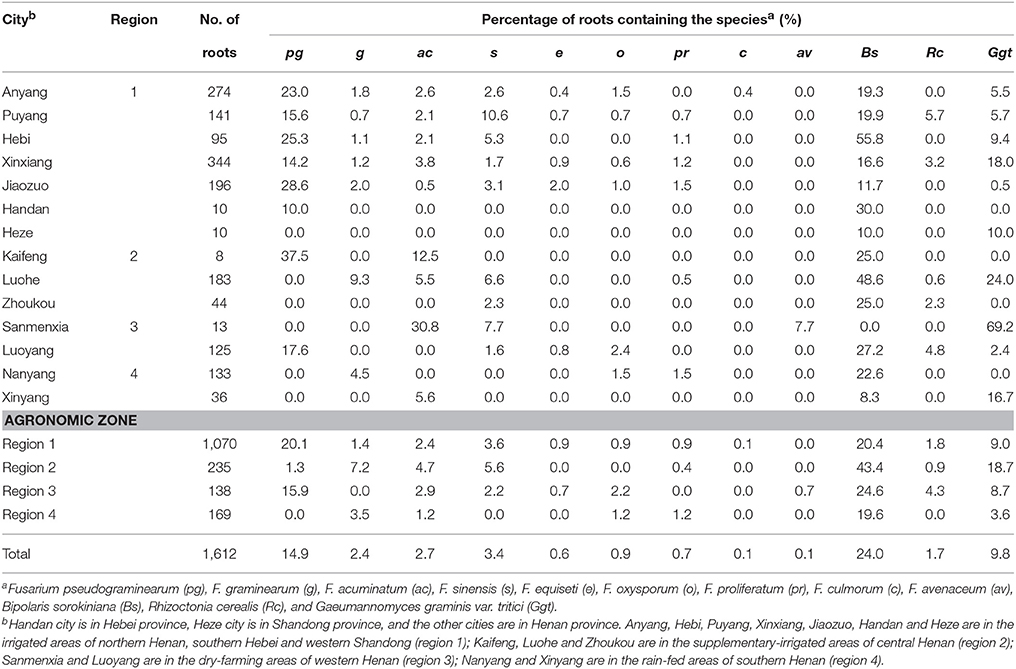
Table 2. Incidence of Fusarium spp., Bipolaris sorokiniana, Rhizoctonia cerealis, and Gaeumannomyces graminis var. tritici isolated from wheat roots from each geographical region during the period from 2013 to 2016.
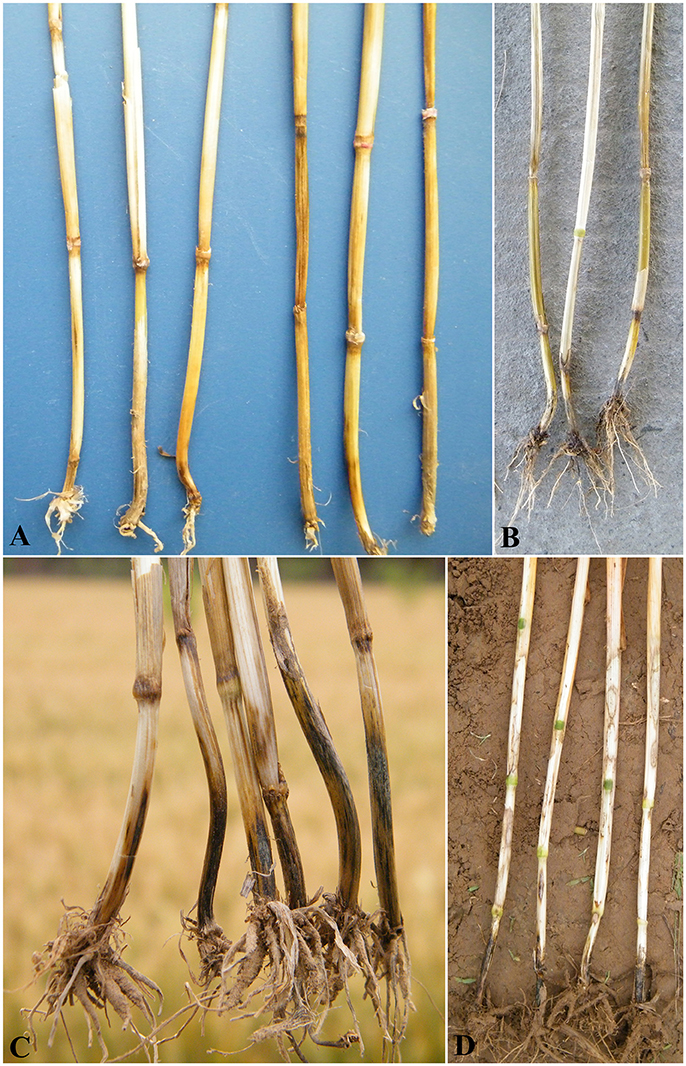
Figure 2. Brown discoloration of lower stem internodes and dark discoloration of nodes caused by Fusarium pseudograminearum and Bipolaris sorokiniana in individual plants (A), Brown discoloration of lower stem internodes caused by F. pseudograminearum and blackening of the basal stem caused by Gaeumannomyces graminis var. tritici also exist alone and coexist in individual plants in the same field (B), Brown discoloration of lower stem internodes caused by B. sorokiniana and blackening of the basal stem caused by G. graminis var. tritici in individual plants (C) and sharp eyespot on the leaf sheath caused by Rhizoctonia cerealis and blackening of the basal stem caused by G. graminis var. tritici in individual plants (D).
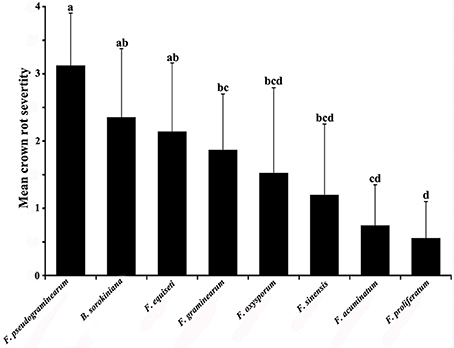
Figure 3. Variation in pathogenicity of 35 isolates of Fusarium spp. (five isolates each of Fusarium pseudograminearum, F. graminearum, F. acuminatum, F. sinensis, F. equiseti, F. oxysporum, and F. proliferatum) and five isolates of Bipolaris sorokiniana on wheat seedlings (Triticum aestivum cultivar “Zhengmai 366”) in a glasshouse with a day/night photoperiod of 12/12 h at a temperature of 25/15°C and relative humidity of 60/80 (±5) % at 35 days after inoculation. Means followed by the same letter are not significantly different (P = 0.05).
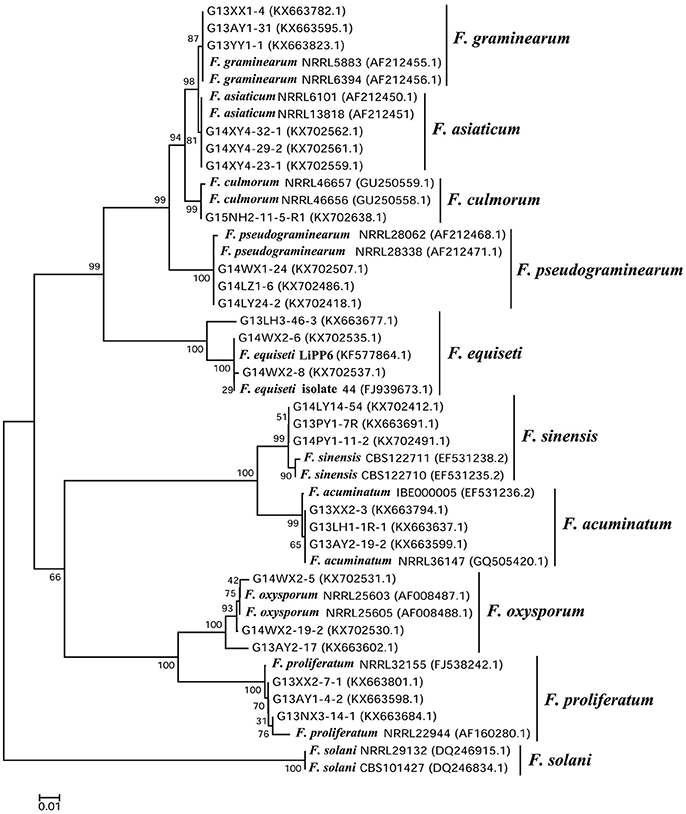
Figure 4. Phylogeny of Fusarium spp. based on the translation elongation factor 1a (EF-1α) gene region (Maximum Likelihood). The bootstrap values (percentage, based on 1,000 replications) are shown on the branches. Some representative strains of Fusarium spp. from this study were selected for the phylogenetic tree. The remaining isolates were retrieved from the National Center for Biotechnology Information database. F. solani was used as an outgroup.
Fusarium pseudograminearum, B. sorokiniana, and G. graminis var. tritici were the predominant pathogens recovered from the wheat root samples, with isolation frequencies of 14.9, 24, and 9.8% (Nroots = 1,612 plants), respectively, whereas F. graminearum, F. acuminatum, F. sinensis, F. equiseti, F. oxysporum, F. proliferatum, F. culmorum, F. avenaceum, and R. cerealis were the minor pathogens identified, with isolation frequencies of 2.4, 2.7, 3.4, 0.6, 0.9, 0.7, 0.1, 0.1, and 1.7%, respectively (Table 2). Similarly, F. pseudograminearum and B. sorokiniana were also the major species found in the stems in these areas, with isolation frequencies of 27.8 and 33.7% (Nstems = 1831 plants), respectively, and F. graminearum, F. asiaticum, F. acuminatum, F. sinensis, F. equiseti, F. oxysporum, F. proliferatum, R. cerealis, and G. graminis var. tritici were the minor pathogens with isolation frequencies of 2.1, 0.4, 2.6, 3.2, 1.3, 0.5, 0.7, 4.4, and 4.4%, respectively (Table 3).
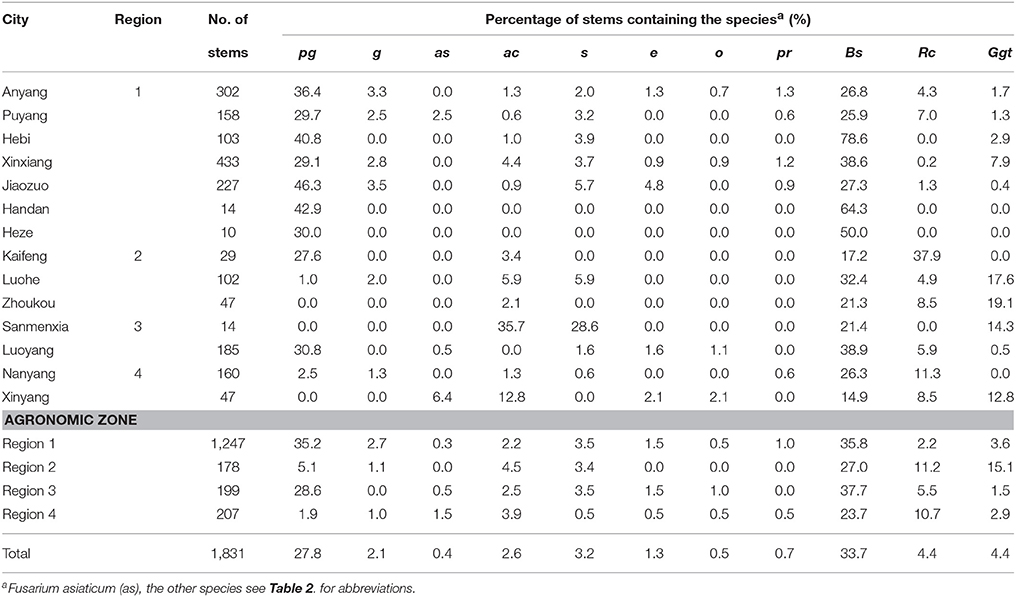
Table 3. Incidence of Fusarium spp., Bipolaris sorokiniana, Rhizoctonia cerealis, and Gaeumannomyces graminis var. tritici isolated from wheat stems from each geographical region during the period from 2013 to 2016.
Fusarium spp., B. sorokiniana, R. cerealis, and G. graminis var. tritici could be found in each of the four agronomic zones in the survey, but the incidence of individual species varied among these zones. The incidence of root and crown rot fungi was calculated as the percentage of isolation frequency from roots or stems in each region. The incidence of F. pseudograminearum was significantly different between region 1 (35.2%, Nstems = 1247 plants) and 4 (1.9%, Nstems = 207 plants) (t = 4.84, df = 56, P < 0.0001; Figure 1), whereas no significant associations were found in the proportion of the other Fusarium spp. with the different agronomic zones. In contrast, the incidence of R. cerealis was significantly different between region 1 (2.2%, Nstems = 1247 plants) and region 4 (10.7%, Nstems = 207 plants) (t = −1.85, df = 16, P < 0.05). However, there were no significant associations in the proportion of B. sorokiniana and G. graminis var. tritici with the different agronomic zones (Figure 1).
Species Diversity in Single Fields and in Individual Plants
In more than 93% of the fields were retrieved two or more of the root and crown rot species isolated from the root and crown tissues of wheat. With respect to individual species, 49% of the fields had F. pseudograminearum, 20.2% had F. graminearum, 3.8% had F. asiaticum, 26% had F. acuminatum, 29.8% had F. sinensis, 82.7% had B. sorokiniana, 21.2% had R. cerealis, and 27.9% had Gaeumannomyces graminis var. tritici (Table 4 and Table S1). The different Fusarium spp. were observed to occurr alone but often coexisted in a single field (45.2%, Nfields = 104) and even within individual plants (1.7%, Nplants = 1902) (Tables S1, S2). For example, both F. pseudograminearum and F. graminearum were present in 11.5% of the fields (Nfields = 104), whereas F. pseudograminearum, together with F. acuminatum, F. sinensis, and F. asiaticum, were present in the same field, with frequencies of 9.6, 10.6, and 2.9%, respectively (Table S1). Similarly, F. graminearum and F. acuminatum were present in 5.8% of the fields (Nfields = 104), whereas F. graminearum, together with F. sinensis and F. asiaticum, were present in the same field, with frequencies of 7.7 and 1.0%, respectively (Table S1).
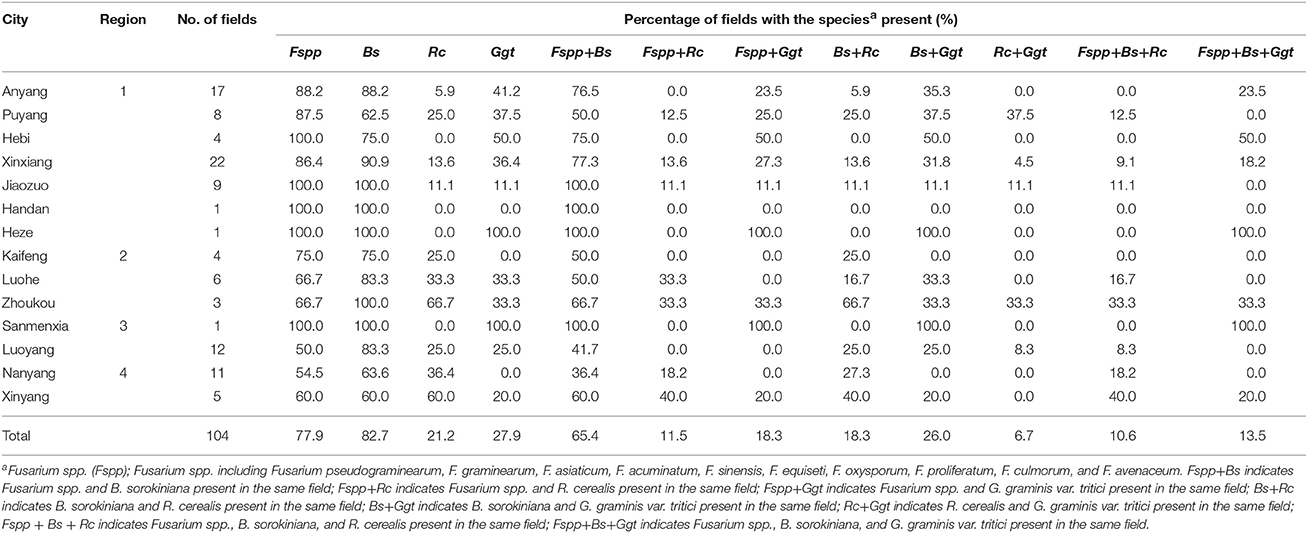
Table 4. Field incidence of fungal species recovered from symptomatic wheat plants collected from wheat fields in 14 cities of China from 2013 to 2016.
Fungal combinations frequently coexisting in the same field and individual plants were Fusarium spp. - B. sorokiniana, Fusarium spp. - R. cerealis, Fusarium spp. - G. graminis var. tritici, B. sorokiniana- R. cerealis, B. sorokiniana- G. graminis var. tritici, and R. cerealis- G. graminis var. tritici. Among the combinations, Fusarium spp. - B. sorokiniana was the most frequent association (Tables 4, 5, Figure 2).
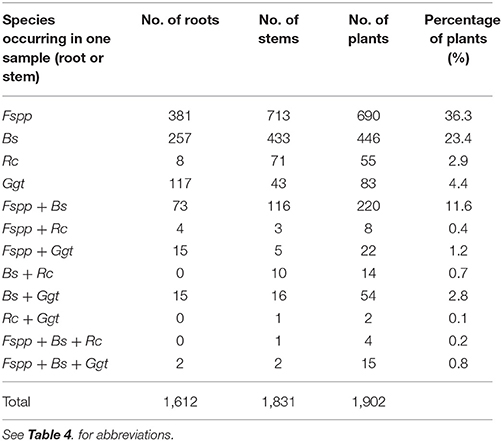
Table 5. Prevalence of Fusarium spp., Bipolaris sorokiniana, Rhizoctonia cerealis, and Gaeumannomyces graminis var. tritici or their combinations recovered from wheat roots or stems of plants sampled from 104 wheat fields from 2013 to 2016 in China.
Correlations Among Climate Variables and Different Species
There were clear relationships between the isolation frequency of a specific pathogen and MAP in the 12 cities, in this survey (Table 6). A negative correlation between the isolation frequency of F. pseudograminearum and MAP in the North China Plain was observed (Table 6). On the contrary, there was a positive correlation between the isolation frequency of F. asiaticum and the MAP during the period from 2013 to 2016. Moreover, a negative correlation between the isolation frequencies of F. pseudograminearum and MTCM was observed in the North China Plain (Table 6). There were clear relationships between the isolation frequencies of two pathogens in the 12 cities, in this survey (Table 6). A negative correlation between the isolation frequency of F. pseudograminearum and G. graminis var. tritici was observed in the North China Plain, while a positive correlation between the isolation frequencies of F. sinensis and F. acuminatum was observed (Table 6).
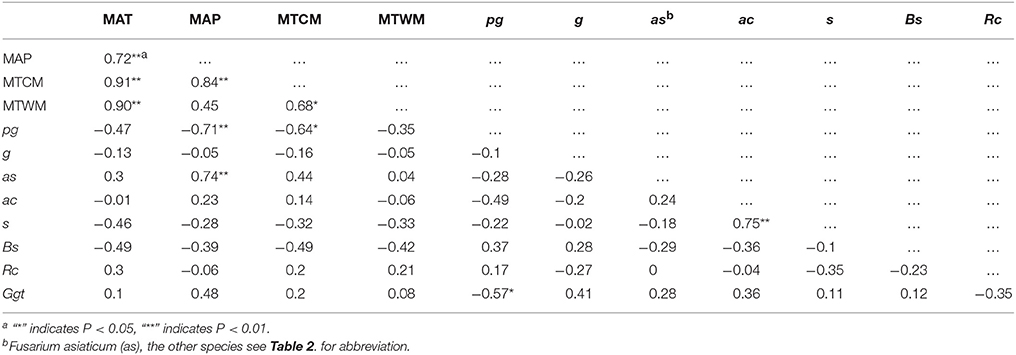
Table 6. Pearson pairwise correlations among climate and isolation frequency of a specific pathogen isolated from roots and stems in an area based on 4-year averages from 2013 to 2016.
Virulence of Different Species on Wheat Seedlings
All isolates of the seven Fusarium spp. and B. sorokiniana were able to cause seedling damping-off and/or rotting of the stem base (Figure 3 and Figure S1). Fusarium pseudograminearum proved to be the most severe pathogen and had a mean crown rot severity of 2.5–3.7 (mean = 3.1) (Figure 3). There was no significant difference in the mean crown rot severity between F. pseudograminearum and B. sorokiniana (mean = 2.3) or F. equiseti (mean = 2.1) (P < 0.05), although the mean crown rot severity of F. pseudograminearum isolates was higher than those of F. graminearum, F. oxysporum, F. sinensis, F. acuminatum, and F. proliferatum (P < 0.05) (Figure 3). Fusarium oxysporum, F. acuminatum, F. sinensis, and F. proliferatum exhibited weak aggressiveness on wheat seedlings and had a mean crown rot severity of 1.5, 1.2, 0.7, and 0.6, respectively.
Discussion
This is the first report of a regional survey of wheat root and crown rot in the North China Plain. The findings presented here are partly in agreement with those of other regional studies conducted across the wheat growing regions of China (Li et al., 2011, 2012; Xu et al., 2014; Zhang et al., 2015). Li et al. (2012) first reported F. pseudograminearum causing FCR from Henan Province in China and F. asiaticum and F. graminearum causing wheat crown rot were found to be the predominant species in Henan, Hebei, and Shangdong in the North China Plain in a study conducted during 2009–2013 (Zhang et al., 2015). However, F. pseudograminearum was shown to be the predominant FCR pathogen in the North China Plain in this study. Although, B. sorokiniana associated with CRR was reported as an important pathogen of root and crown rot in wheat only in Jiangsu province of China (Li et al., 2011), it is now considered to be the major pathogen for this disease, with high field incidence (82.7%) and isolation frequency from roots (24%) and stems (33.7%) of wheat in the North China Plain (Tables 2, 3).
In this study, we found few isolates of F. graminearum, F. asiaticum, F. acuminatum, F. sinensis, F. equiseti, F. oxysporum, F. proliferatum, F. culmorum, F. avenaceum, and R. cerealis. In previous studies, these Fusarium spp. have been reported to cause wheat crown and foot rot in the PNW of the USA (Smiley and Patterson, 1996; Paulitz et al., 2002) and South Australia (Williams et al., 2002). Among the minor FCR pathogens, F. graminearum, F. asiaticum, F. acuminatum, F. culmorum, and F. avenaceum were already reported from China (Zhang et al., 2015; Ji et al., 2016; Li et al., 2016), while F. sinensis, F. equiseti, F. oxysporum, and F. proliferatum were first detected in this study. Especially, the F. sinensis isolates were found to be widely distributed and predominant in region 2. This is the first report of the association between F. sinensis and wheat FCR (Figure 1 and Figure S1). The ability of F. sinensis to cause FCR remains unknown when this species was first found in wheat seed and root samples, as reported by Zhao and Lu (2008). In contrast, in the present study, 113 F. sinensis isolates from wheat FCR were found in the North China Plain (Table 2, Figure 1). In addition, the F. culmorum isolates were the dominant pathogens in the cooler and higher rainfall areas of the PNW of the United States, the high rainfall region of Victoria in Australia, the South-East region of South Australia, and Turkey (Backhouse et al., 2004; Chakraborty et al., 2006; Tunali et al., 2008; Poole et al., 2013). Conversely, we recovered only one isolate of F. culmorum associated with wheat FCR in China (Table 2). Our data are in according to data of Li et al. (2016) that also recovered a single isolate of F. culmorum. Thus, this species does not appear to be as prevalent in China as in the other wheat-growing areas of the world.
We observed that the distribution frequency of F. pseudograminearum was higher in the low-rainfall areas in the North China Plain. The isolation frequency of F. pseudograminearum was higher in region 1 (462.2–546.5 mm annual rainfall during 2013–2016) and region 3 (564.2–587.6 mm annual rainfall during 2013–2016) compared to that in region 2 (520.7–752.4 mm annual rainfall during 2013–2016) and region 4 (732.2–1084.8 mm annual rainfall during 2013–2016) (Table 1, Figure 1). We detected a negative correlation between the frequency of occurrence of F. pseudograminearum and mean annual precipitation during 2013–2016 (r = −0.71; P < 0.01; Table 4). Similarly, F. pseudograminearum was predominant in the low-rainfall areas (with 250–500 mm rainfall) of the PNW of the USA (Smiley and Patterson, 1996; Poole et al., 2013), and Queensland and New South Wales in Eastern Australia (Akinsanmi et al., 2004). Other studies have suggested that the distribution of F. pseudograminearum was not only related to low rainfall, but also to raised temperatures in summer or elevated levels of carbon dioxide (Melloy et al., 2010; Moya-Elizondo et al., 2011).
In a previous study it was found that F. asiaticum and F. graminearum, causing wheat crown rot, were predominant in Henan, Hebei, and Shangdong in the North China Plain during 2009–2013 (Zhang et al., 2015). However, according to our results, the incidence of F. graminearum and F. asiaticum in the crown rot of wheat varied with the agronomic zone. Fusarium graminearum was predominant in regions 2 and 4 and was also scattered across region 1 (Figure 1). Fusarium asiaticum was found in region 4 (Figure 1). A positive correlation between the mean annual precipitation during 2013–2016 and the frequency of occurrence of F. asiaticum (r = 0.74; P < 0.01) was observed (Table 4).
Although R. cerealis is reported to be widespread in winter wheat in China (Chen et al., 2009), in our study, it was found to be more common in the wet areas, with the incidence being higher in regions 2 and 4 compared to that in regions 1 and 3 (Figure 1). Moreover, there was a significant difference in the incidence between regions 1 and 4.
FCR was once considered a component of common root rot, caused by B. sorokiniana, because of the occurrence of root rots caused by both pathogens in the same plant (Smiley and Patterson, 1996; Cook, 2010). Our results confirm this finding. The coexistence of Fusarium spp. and B. sorokiniana in the same field or in individual plants was more common than that of Fusarium spp. and R. cerealis or G. graminis var. tritici (Tables 4, 5, Figure 2). In previous studies, R. cerealis and B. sorokiniana or F. culmorum were found together from the group of stems in a particular field (Tunali et al., 2008). These results have also been confirmed in this study. However, we found other combinations of different species in the same field and in an individual plant. For example, G. graminis var. tritici and B. sorokiniana or Fusarium spp. were found to co-exist in the same field or in individual plants in this study (Tables 4, 5, Figure 2).
The results of seedling pathogenicity tests are in agreement with previous reports on the fungal pathogenicity of crowns or leaf sheath of wheat seedlings. Fusarium pseudograminearum, F. graminearum, and B. sorokiniana caused the damping-off of seedlings and rotted stem bases that resulted in the death of seedlings and were the most aggressive pathogens on wheat (Smiley and Patterson, 1996; Fernandez and Chen, 2005; Zhang et al., 2015). Other Fusarium strains that caused less severe FCR on wheat seedlings in greenhouse tests included some isolates of F. equiseti, F. oxysporum, F. acuminatum, and F. proliferatum (Akinsanmi et al., 2004; Fernandez and Chen, 2005; Chakraborty et al., 2006; Cook, 2010). However, in contrast to our results, F. proliferatum was observed to exhibit the same degree of aggressiveness as F. pseudograminearum and was more aggressive than F. acuminatum (Akinsanmi et al., 2004).
Conclusion
Our results are in agreement with those of previously published studies wherein the pathogens of FCR, CRR, sharp eyespot, and take-all afflicting wheat were identified from China. However, our findings also demonstrate that the recovered species varied with the agronomic zone. The incidence of F. pseudograminearum and R. cerealis was significantly different between regions 1 and 4. A negative correlation was observed between the frequency of F. pseudograminearum occurrence and MAP during 2013–2016 in the North China Plain. We also observed Fusarium spp. - B. sorokiniana was the most frequent association. Moreover, for the first time, we report the association between F. sinensis and wheat FCR. Future research should focus on the current levels of resistance or tolerance to different species, which varied in the agronomic zones in local cultivars of the North China Plain. This work on species distribution has far-reaching implications that would maximize the efficiency of wheat breeding and management.
Author Contributions
YS and FX were responsible for coordinating the work (planning, implementation, and interpretation) and writing this manuscript. GY, JW, YL, and ZH conducted the fieldwork and were involved in the survey and sampling. KZ conducted the laboratory work and was involved in the isolation, culture, and identification of species. LL was responsible for all DNA analyses.
Conflict of Interest Statement
The authors declare that the research was conducted in the absence of any commercial or financial relationships that could be construed as a potential conflict of interest.
Funding
This research was funded by the National Non-Profit Industry-Funded Research and Special Projects (201303016) and by funds earmarked for the National Key R&D Program of China (2017YFD0201700 and 2016YFD0300705).
Acknowledgments
We thank Prof. Yi-ling Zhou and Ke-hui Zhan for helping us with the statistical analyses. We also thank all the technicians and students who helped us in conducting the field trials and disease evaluations.
Supplementary Material
The Supplementary Material for this article can be found online at: https://www.frontiersin.org/articles/10.3389/fmicb.2018.01054/full#supplementary-material
Figure S1. Colony morphology on potato dextrose agar (PDA) (25°C, darkness, 6 days), pathogenicity of isolates G14LY24-2 (Fusarium pseudograminearum), G13YY1-4-2 (F. graminearum), G13XX2-3 (F. acuminatum), G13AY1-25 (F. sinensis), G13LH3-46-3 (F. equiseti), G14WX2-19-2 (F. oxysporum), G13AY1-4-2 (F. proliferatum), and G14LY24-4-1 (Bipolaris sorokiniana) on wheat seedlings (Triticum aestivum cultivar “Zhengmai 366”) in a glasshouse with a day/night photoperiod of 12/12 h at a temperature of 25/15°C and relative humidity of 60/80 (±5) % at day 35 after inoculation.
Table S1. Prevalence of Fusarium pseudograminearum, F. graminearum, F. asiaticum, F. acuminatum, and F. sinensis or combinations recovered from wheat plants sampled from 104 wheat fields in 2013–2016 in China.
Table S2. Plant numbers of mixed infection types of different Fusarium spp.
Table S3. GenBank Accession numbers (partial translation elongation factor-1α gene sequences) of Fusarium spp. isolated form wheat roots and stems from the North China Plain in 2013–2016.
References
Akinsanmi, O., Mitter, V., and Chakraborty, S. (2004). Identity and pathogenicity of Fusarium spp. isolated from wheat fields in Queensland and northern New South Wales. Austral. J. Agricul. Res. 55, 97–107. doi: 10.1071/AR03090
Backhouse, D., Abubakar, A. A., Burgess, L. W., Dennis, J. I., Hollaway, G. J., Wildermuth, G. B., et al. (2004). Survey of Fusarium species associated with crown rot of wheat and barley in eastern Australia. Austral. Plant Pathol. 33, 255–261. doi: 10.1071/AP04010
Backhouse, D., and Burgess, L. W. (2002). Climatic analysis of the distribution of Fusarium graminearum, F. pseudograminearum and F. culmorum on cereals in Australia. Australas. Plant Pathol. 31, 321–327. doi: 10.1071/AP02026
Bentley, A. R., Milgroom, M. G., Leslie, J. F., Summerell, B. A., and Burgess, L. W. (2009). Spatial aggregation in Fusarium pseudograminearum populations from the Australian grain belt. Plant Pathol. 58, 23–32. doi: 10.1111/j.1365-3059.2008.01910.x
Burgess, L. W., Backhouse, D., Summerell, B. A., and Swan, L. J. (2001). “Crown rot of wheat,” in Fusarium: Paul E. Neison Memorial Symposium. eds B. A. Summerell., J. F. Leslie., D. Backhouse., W. L. Bryden., and L. W. Burgess (St Paul, MN: The American Phytotathological Society), 271–294.
Chakraborty, S., Liu, C. J., Mitter, V., Scott, J. B., Akinsanmi, O. A., Ali, S., et al. (2006). Pathogen population structure and epidemiology are keys to wheat crown rot and Fusarium head blight management. Austral. Plant Pathol. 35, 643–655. doi: 10.1071/AP06068
Chen, Y., Li, W., Zhang, X. X., Zhang, B. Q., Yu, H. S., and Chen, H. G. (2009). Composition and virulence of pathogen of wheat sharp eyespot in north latitude 33 of China. J. Triticeae Crops 29, 1110–1114. Available online at http://www.paper.edu.cn/journal/showPdf/MUjGIF3QMRzVUI1eQ
Cook, R. J. (2010). “Fusarium root, crown, and foot rots and associated seedling disease,” in Compendium of Wheat Diseases and Pests, 3rd Edn., eds W. W. Bockus, R. L. Bowden, R. M. Hunger, W. L. Morrill, T. D. Murray and R. W. Smiley (New York, NY: APS press), 37–39.
Fang, Z. D. (1998). “Sampling method,” in Research Methodology for Plant Diseases, 3rd Edn., ed H. G. Zhang (Beijing: Chinese Agriculture Press), 5–7.
Fernandez, M. R., and Chen, Y. (2005). Pathogenicity of Fusarium species on different plant parts of spring wheat under controlled conditions. Plant Dis. 89, 164–169. doi: 10.1094/PD-89-0164
Fernandez, M. R., Holzgang, G., and Turkington, T. K. (2009). Common root rot of barley in Saskatchewan and north-central Alberta. Can. J. Plant Pathol. 31, 96–102. doi: 10.1080/07060660909507577
Hu, Y. J., and Yin, J. (2014). “Cultivation techniques of high yield of wheat in different ecological areas of Henan,” in Major Scientific Research Achievements in Agriculture Ecological Cultivation of Wheat, eds X. W. Li and X. Bai (Beijing: Science Press), 194–197.
Ji, L. J., Li, Q. S., Wang, L. S., Sun, M. W., Wang, Y. J., and Kong, L. X. (2016). Occurrence and pathogen composition of wheat crown rot in Hebei Province. Plant Prot. 42, 154–157. doi: 10.3969/j.issn.0529-1542.2016.05.027
Large, E. C. (1954). Growth stages in cereals illustration of the Feekes scale. Plant Pathol. 3, 128–129. doi: 10.1111/j.1365-3059.1954.tb00716.x
Leslie, J. F., and Summerell, B. A. (2006). The Fusarium Laboratory Manual. Ames, IA: Blackwell Publishing.
Li, H. L., He, X. L., Ding, S. L., Yuan, H. X., and Chen, L. L. (2016). First report of Fusarium culmorum causing crown cot of wheat in China. Plant Dis. 100:2532. doi: 10.1094/PDIS-05-16-0723-PDN
Li, H. L., Yuan, H. X., Fu, B., Xing, X. P., Sun, B. J., and Tang, W. H. (2012). First report of Fusarium pseudograminearum causing crown rot of wheat in Henan, China. Plant Dis. 96:1065. doi: 10.1094/PDIS-01-12-0007-PDN
Li, W., Chen, Y., Zhang, X. X., Zhang, B. Q., Yu, H. S., and Chen, H. G. (2011). Pathogenic fungi of wheat brown foot rot and their pathogenicity in China. J. Triticeae Crops 31, 170–175. doi: 10.7606/j.issn.1009-1041.2011.01.030
Melloy, P., Hollaway, G., Luck, J., Norton, R., Aitken, E., and Chakraborty, S. (2010). Production and fitness of Fusarium pseudograminearum inoculum at elevated carbon dioxide in FACE. Global Change Biol. 16, 3363–3373. doi: 10.1111/j.1365-2486.2010.02178.x
Mitter, V., Zhang, M. C., Liu, C. J., Ghosh, R., Ghosh, M., and Chakraborty, S. (2006). A high-throughput glasshouse bioassay to detect crown rot resistance in wheat germplasm. Plant Pathol. 55, 433–441. doi: 10.1111/j.1365-3059.2006.01384.x
Moya-Elizondo, E. A. (2013). Fusarium crown rot disease: biology, interactions, management and function as a possible sensor of global climate change. Cien. Inv. Agr. 40, 235–252. doi: 10.4067/S0718-16202013000200001
Moya-Elizondo, E., Rew, L. J., Jacobsen, B. J., Hogg, A. C., and Dyer, A. T. (2011). Distribution and prevalence of Fusarium crown rot and common root rot pathogens of wheat in Montana. Plant Dis. 95, 1099–1108. doi: 10.1094/PDIS-11-10-0795
O'Donnell, K., Kistler, H. C., Tacke, B. K., and Casper, H. H. (2000). Gene genealogies reveal global phylogeographic structure and reproductive isolation among lineages of Fusarium graminearum, the fungus causing wheat scab. Proc. Natl. Acad. Sci. U.S.A. 97, 7905–7910. doi: 10.1073/pnas.130193297
O'Donnell, K., Ward, T. J., Geiser, D. M., Kistler, H., and Aoki, T. (2004). Genealogical concordance between the mating type locus and seven other nuclear genes supports formal recognition of nine phylogenetically distinct species within the Fusarium graminearum clade. Fungal Genet. Biol. 41, 600–623. doi: 10.1016/j.fgb.2004.03.003
Paulitz, T. C. (2010). “Take-all,” in Compendium of Wheat Diseases and Pests, 3rd Edn., eds W. W. Bockus, R. L. Bowden, R. M. Hunger, W. L. Morrill, T. D. Murray and R. W. Smiley (New York, NY: APS press), 79–82.
Paulitz, T. C., Smiley, R. W., and Cook, R. J. (2002). Insight into the prevalence and management of soilborne cereal pathogens under direct seeding in the Pacific Northwest, U.S.A. Can. J. Plant Pathol. 24, 416–428. doi: 10.1080/07060660209507029
Poole, G. J., Smiley, R. W., Walker, C., Huggins, D., Rupp, R., Abatzoglou, J., et al. (2013). Effect of climate on the distribution of Fusarium spp. causing crown rot of wheat in the Pacific Northwest of the United States. Phytopathology 103, 1130–1140. doi: 10.1094/PHYTO-07-12-0181-R
Proctor, R. H., McCormick, S. P., Alexander, N. J., and Desjardins, A. E. (2009). Evidence that a secondary metabolic biosynthetic gene cluster has grown by gene relocation during evolution of the filamentous fungus Fusarium. Mol. Microbiol. 74, 1128–1142. doi: 10.1111/j.1365-2958.2009.06927.x
Smiley, R. W., Gourlie, J. A., Easley, S. A., Patterson, L.-M., and Whittaker, R. G. (2005). Crop damage estimates for crown rot of wheat and barley in the Pacific Northwest. Plant Dis. 89, 595–604. doi: 10.1094/PD-89-0595
Smiley, R. W., and Patterson, L.-M. (1996). Pathogenic fungi associated with Fusarium foot rot of winter wheat in the semiarid Pacific Northwest. Plant Dis. 80, 944–949. doi: 10.1094/PD-80-0944
Smiley, R. W., and Yan, H. (2009). Variability of Fusarium crown rot tolerances among cultivars of spring and winter wheat. Plant Dis. 93, 954–961. doi: 10.1094/PDIS-93-9-0954
Stein, J. M. (2010). “Common root and foot rot and associated leaf and seedling disease,” in Compendium of Wheat Diseases and Pests, 3rd Edn, eds W. W. Bockus, R. L. Bowden, R. M. Hunger, W. L. Morrill, T. D. Murray and R. W. Smiley (New York, NY: APS press), 26–28.
Strausbaugh, C. A., Bradley, C. A., Koehn, A. C., and Forster, R. L. (2004). Survey of root diseases of wheat and barley in southeastern Idaho. Can. J. Plant Pathol. 26, 167–176. doi: 10.1080/07060660409507128
Tunali, B., Nicol, J. M., Hodson, D., Uçkun, Z., Büyük, O., Erdurmuş, D., et al. (2008). Root and crown rot fungi associated with spring, facultative, and winter wheat in Turkey. Plant Dis. 92, 1299–1306. doi: 10.1094/PDIS-92-9-1299
White, T. J., Bruns, T. D., Lee, S., and Taylor, J. W. (1990). “Amplification and direct sequencing of fungal ribosomal RNA genes for phylogenetics,” in PCR Protocols: A Guide to Methods and Applications, eds M. A. Innis, D. H. Gelfand, J. S. Sninsky and T. J. White (New York, NY: Academic Press), 315–322.
Williams, K. J., Dennis, J. I., Smyl, C., and Wallwork, H. (2002). The application of species-specific assays based on the polymerase chain reaction to analyse Fusarium crown rot of durum wheat. Austral. Plant Pathol. 31, 119–127. doi: 10.1071/AP01079
Xu, F., Song, Y. L., Zhou, Y. L., Zhang, H., Wang, J. M., Li, Y. H., et al. (2016). Occurrence dynamics and characteristics of Fusarium root and crown rot of wheat in Henan Province during 2013-2016. Plant Prot. 42, 126–132. doi: 10.3969/j.issn.05291542.2016.06.023
Xu, F., Yang, G. Q., He, W. L., Wang, J. M., Song, Y. L., and Li, Y. H. (2014). Composition and virulence diversity in Gaeumannomyces graminis var. tritici populations infecting wheat in Henan province. J. Plant Prot. 41, 255–256. Available online at http://www.wanfangdata.com.cn/details/detail.do?_type=perio&id=zwbhxb201402022
Zhang, J. C., Zhu, X. T., Liu, Y. X., and Li, H. Q. (1988). Studies on the root rot of wheat. J. Nat. Sci. Heilongjiang Univ. 2, 68–74.
Zhang, X.-X., Sun, H.-Y., Shen, C.-M., Li, W., Yu, H.-S., and Chen, H.-G. (2015). Survey of Fusarium spp. causing wheat crown rot in major winter wheat growing regions of China. Plant Dis. 99, 1610–1615. doi: 10.1094/PDIS-04-14-0422-RE
Keywords: root and crown rot of wheat, Fusarium pseudograminearum, the North China Plain, Bipolaris sorokiniana, Rhizoctonia cerealis
Citation: Xu F, Yang G, Wang J, Song Y, Liu L, Zhao K, Li Y and Han Z (2018) Spatial Distribution of Root and Crown Rot Fungi Associated With Winter Wheat in the North China Plain and Its Relationship With Climate Variables. Front. Microbiol. 9:1054. doi: 10.3389/fmicb.2018.01054
Received: 12 January 2018; Accepted: 03 May 2018;
Published: 25 May 2018.
Edited by:
Raffaella Balestrini, Consiglio Nazionale delle Ricerche (CNR), ItalyReviewed by:
Samuele Voyron, Università degli Studi di Torino, ItalyLászló Kredics, University of Szeged, Hungary
Copyright © 2018 Xu, Yang, Wang, Song, Liu, Zhao, Li and Han. This is an open-access article distributed under the terms of the Creative Commons Attribution License (CC BY). The use, distribution or reproduction in other forums is permitted, provided the original author(s) and the copyright owner are credited and that the original publication in this journal is cited, in accordance with accepted academic practice. No use, distribution or reproduction is permitted which does not comply with these terms.
*Correspondence: Yuli Song, c29uZ3l1bGkyMDAwQDEyNi5jb20=
 Fei Xu
Fei Xu Gongqiang Yang
Gongqiang Yang Yuli Song
Yuli Song